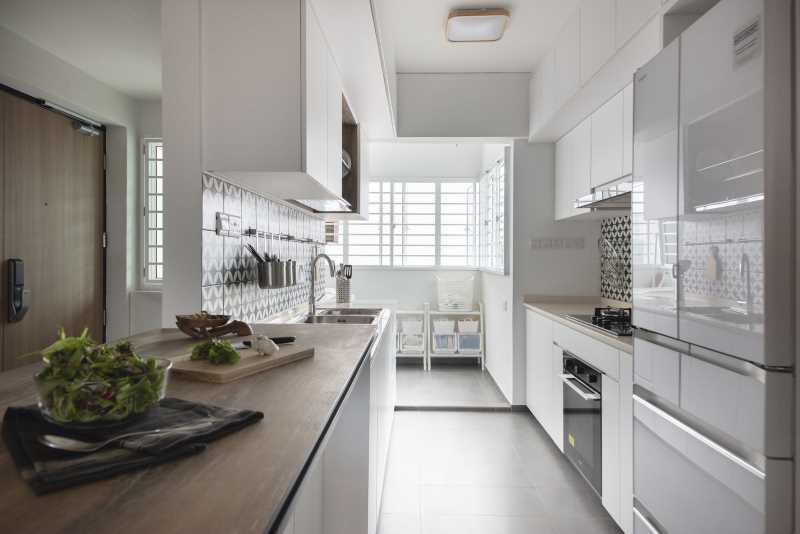How To Organize Your Kitchen In 5 Easy Steps
Interior Design & Decor5 minutes read
2113 views
2113 views
(Guest Writer: Mirela Boston)
Just like a car’s steering wheel, dashboard, and levers fit around the driver, the space and kitchen cabinets around your oven and hob must be comfortable and easy for you “to drive”.
The hob and oven area is the command centre of the kitchen. Adopt that mindset as you continue to organize your entire kitchen and plan how to use your unassembled kitchen cabinets.
 Kitchen done by The Safe Haven Interiors
Kitchen done by The Safe Haven Interiors
1. Handle it!
Are you left-handed or right-handed? A key feature of a well-organized kitchen is ergonomic efficiency. Have the doors open towards your dominant hand, to make door opening easier.
Planning a kitchen is an opportunity to place the door handles on the correct side for you, at the correct height. It is instinctive and easier to open a door with our dominant hand, whilst we hold the dish to be placed inside the cabinet with our other hand.
2. Straighten Up!
How tall or short are you? Easy access to appliances is a trademark of an organized kitchen. Arrange frequently used and heavier objects on easy-to-access shelves. There’s no rule that heavy pots and pans have to go on the bottom of the under-counter cabinet, obliging you to squat and lift deadweight.
Equally, don’t have heavy items above head height. Straining on tiptoes to reach what we can’t see properly is not ideal. The less frequently used appliances and equipment should be stored in cabinets farthest from the command centre of the kitchen.
3. Unhinged!
An organized kitchen is clever. If you are going to start assembling unassembled kitchen cabinets, be sure to use hinges that allow doors to open more than 90 degrees. Wider opening doors make it easier to take bigger items out of the cabinet without scraping your knuckles. Most cabinet doors are strained when being opened.
When we are trying to retrieve stuff from the cabinets, we may have forced doors to open beyond their capacity, thus straining the hinge where it is fitted to the cabinet carcass. Wider opening hinges will ease the strain on the doors.
A door that can open wider also prevents us from leaning on the door while we are bending over to peer inside. Leaning on the door forces the door down, thereby increasing the strain on the hinges over time and also skews the door’s 'square' alignment. We need to avoid doing that.
4. Be Shelf-fish!
Don’t accommodate selfish shelves. Kitchen organization requires plenty of shelf space. Most cabinet shelves are height adjustable. Insert extra shelves where space allows. A tape measure should become your new best friend. Use a shelf from a cabinet as a template for extra shelves to be made up for you at your local DIY store.
For those with some skill, attach drawer runners to a couple of shelves so that the shelves can be pulled forward for easy access to the items at the back of the shelf. This works well for organizing your plastic food containers and will help in the fight against the container lids going missing.
5. Trash Talk!
Start a loving relationship with your garbage disposal and recycling bins. An organized kitchen includes consideration for operational efficiency, helping recycling become an easy habit.
Don’t choke the disposal to death by stuffing it to the max. Don’t have your recycle bins out of your (door) sight, because out of sight is out of mind. Organizing the space outside your kitchen is just as important as organizing the space inside your kitchen.
Final Words
So as you set about organizing your kitchen, think about the principles of organization which has been suggested above. An organized kitchen is intuitive – the way cabinets open just feels right.
An organized kitchen considers ergonomics – it reduces the strain placed on our bodies by reducing the need to take things down from high shelves or lift heavy things from a squat position.
An organized kitchen includes modern-day requirements – such as the location of recycling facilities to encourage positive recycling habits.
An organized kitchen is an optimized space – it optimizes the use of space through additional and adjustable shelving.
Request for quotes and we'll match you with a selection of Interior Designers!
Previous
3 Simple Tricks To Make Your Home More Comfortable


 Sign Up with Google
Sign Up with Google

.jpg)

